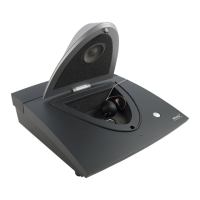Affinity
2.0
Additional Information Page 263
Question:
What kind of stimulus does Interacoustics recommend to be used and in different situations?
Answer:
Choosing the correct stimuli for the purpose is extremely important as it is the basis of a good measurement
with a valid result. Digital hearing aids automatically adjust the amplification depending on the input. This
capacity, however, cannot be reflected in a real-ear measurement unless a realistic and dynamic test
stimulus like speech is used (Fabry 2004).
Using Tone Stimuli
For many years pure tones (sinusoids)/warble tones were the primary signals used for real-ear as well as
coupler verification. Tone signals are “simple” signals and only one frequency is presented at the time.
Therefore, real-ear measurements performed with tone signals do not reflect advanced signal processing
where frequencies interact (Kuk & Ludvigsen 2003).
Using Speech Stimuli/ISTS
Speech is likely to be most important signal to the hearing aid user in his or her daily life. Therefore, if you
wish to verify if speech sounds are audible there is no better stimulus than speech. When using a speech
signal the hearing aid will also stand its test since speech has the challenge of changing quickly in amplitude,
frequency, and phase.
ISTS (International Speech Test Signal) is an internationally recognized test signal. It was created based on
the need for a standard test stimulus that included all the relevant properties of speech and allowed for
reproducible measurement conditions. It is created from natural recordings of speech which is non-intelligible
due to remixing and segmentation. The signal reflects a female speaker for six different mother tongues
(American English, Arabic, Chinese, French, German, and Spanish) reading “The north wind and the sun”.
The ISTS is shaped according to the LTASS (Long Term Average Speech Spectrum) standards (Holube et
al. 2007).
Using Composite Signals/ICRA
Artificial signals without significant variation in intensity and frequency can also be used in order to test
hearing aids in the frequencies of speech. These are called speech spectrum shaped composite signals and
have the same long-term spectral characteristics as speech.
The advantages in such signals are that you are able to test many frequencies in a short time and that
interactions among frequencies can be tested.
The ICRA signals (International Collegium of Rehabilitative Audiology) are examples of composite signals.
They are a group of test signals developed by the HACTES group (Hearing Aid Clinical Test Environment
Standardisation) in order to be able to do reliable measurements on non-linear digital hearing aids. They
represent a number of speech weighted noise signals composed with spectral and temporal characteristics
similar to those that are found in speech signals and babble noise. (www.icra.nu).
What Stimulus to choose?
Which stimulus to select depends on your focus and the individual patient.
If for example seeing a patient who complains about not being able to hear his wife, you may want to try the
ISTS.
If the patient is having trouble when more than one person is speaking, the ICRA 6pbl (or one of the other
signals with multiple people speaking) may be selected.
If you wish to look at the effects of a noise reduction, a noise signal such as Pink Noise may be the
appropriate choice.
Note that your choice has an impact on your result as illustrated below:

